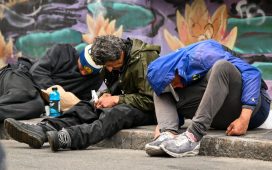The US announced its fourth human case of bird flu, in a Colorado dairy worker, on Wednesday, as officials work to expand the availability of potential vaccines and commercial tests and open up financial assistance for affected farmers.
The dairy worker was in close contact with cows that had tested positive for H5N1, a highly pathogenic bird flu, and the worker reported only “eye symptoms”, according to the Centers for Disease Control and Prevention (CDC).
The person took antiviral medication and has recovered, the CDC said. The agency is sequencing a sample of the virus to see if it has developed any concerning mutations.
More than 780 people have been monitored for symptoms and at least 53 have been tested for H5N1 this year, the CDC reports. The vast majority of those tests have been performed in Michigan.
Colorado has the highest number of affected herds, according to the US Department of Agriculture (USDA). A cat in Colorado has also tested positive after no known contact with poultry or dairy operations.
Prior to this year’s outbreak in dairy cattle, the only previous US case in humans was detected in Colorado in 2022, after an incarcerated person was exposed to the virus while culling a flock of infected poultry.
The new case followed an announcement the day before from US officials about plans to build up the supply of H5N1 vaccines and expand the availability of tests.
The US is partnering with the vaccine maker Moderna to help develop and manufacture mRNA bird flu vaccines “if needed”, said Dawn O’Connell, assistant secretary for preparedness and response (ASPR). Trials for safety and efficacy in people would probably begin next year, she said.
While the $176m contract focuses on H5N1 vaccines, it could also be used on developing or procuring vaccines targeting other strains of influenza or emerging infectious diseases, McConnell said.
The US has also ordered 4.8m doses of another type of H5N1 vaccine, which are expected to come off the production line in the middle of July, “faster than we had initially anticipated”, McConnell said.
These vaccines would still need to be approved by the Food and Drug Administration (FDA) before they could be given to people.
The risk to humans from bird flu remained low, officials said, and H5N1 vaccines are not recommended for anyone at this point.
Officials also floated the possibility of using influenza antivirals to prevent transmission of the H5N1 virus among people, if it mutates to become more effective at human-to-human spread.
“The vaccines tend to be better at preventing severe disease rather than transmission,” said Nirav Shah, principal deputy director of the CDC, adding that more widespread distribution of antivirals could help with the latter.
Expanding test availability could mean those at risk for contracting H5N1 could go to a commercial lab to get tested, which could make testing more accessible and faster.
Right now, the US has about 750,000 tests for H5N1, and another 1.2m expected in the next two to three months, all of which are conducted in public health laboratories. The CDC is working to share its test designs with commercial companies, and on 10 June the agency opened a call for companies to propose new H5N1 test designs.
On Monday, the USDA opened up a financial assistance program to dairy producers with herds affected by H5N1. While infected cows usually survive, their milk production often plummets, and disposing of H5N1-infected milk means lost income.
The new program allows any dairy farmers with H5N1-positive cows to apply for federal assistance, similar to programs that exist for poultry farmers who lose flocks. Experts hope it will encourage producers to test their herds and help contain the spread of bird flu.
Six states have also enrolled in the USDA’s voluntary dairy herd status pilot program, and 24 herds are enrolled in the agency’s financial support programs to enhance biosecurity and testing on farms.
Bird flu vaccines for cows are also being studied, but that process takes time, said Eric Deeble, acting senior adviser for the USDA’s H5N1 response. “It will take a while for any vaccine … to become available, and in the interim, we’re going to continue to stress biosecurity” – for example, limiting the number of people on farms, or cleaning and disinfecting equipment and clothing. Studies so far indicate that people are moving the virus between farms via shared workers, cows, vehicles and equipment.











